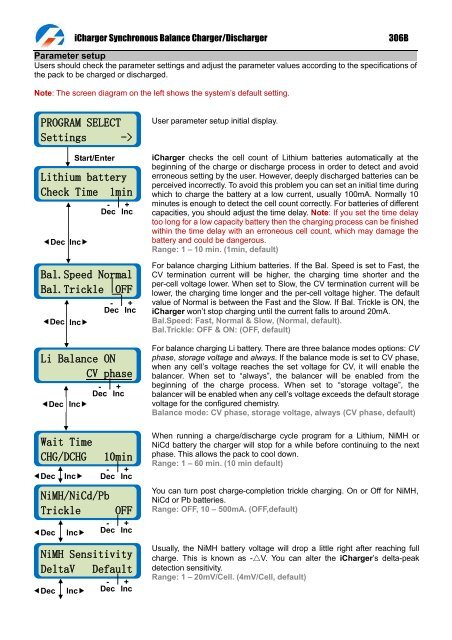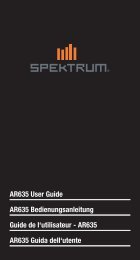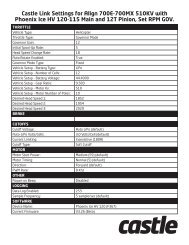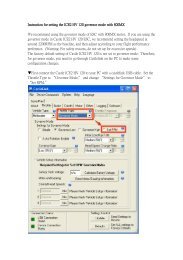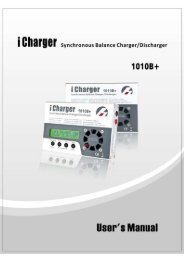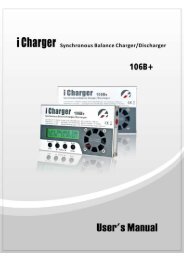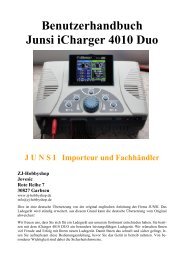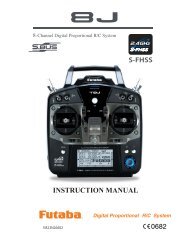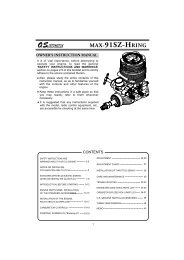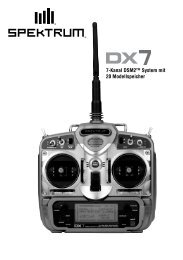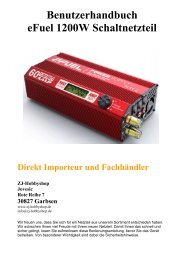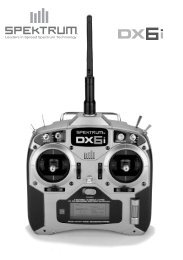iCharger 306B Manual - RC Station CH
iCharger 306B Manual - RC Station CH
iCharger 306B Manual - RC Station CH
Create successful ePaper yourself
Turn your PDF publications into a flip-book with our unique Google optimized e-Paper software.
<strong>iCharger</strong> Synchronous Balance Charger/Discharger <strong>306B</strong><br />
Parameter setup<br />
Users should check the parameter settings and adjust the parameter values according to the specifications of<br />
the pack to be charged or discharged.<br />
Note: The screen diagram on the left shows the system‘s default setting.<br />
PROGRAM SELECT<br />
Settings -><br />
Start/Enter<br />
Lithium battery<br />
Check Time 1min<br />
Dec<br />
Inc<br />
Bal.Speed Normal<br />
Bal.Trickle OFF<br />
Dec<br />
Inc<br />
-<br />
Dec +<br />
Inc<br />
-<br />
Dec +<br />
Inc<br />
Li Balance ON<br />
CV phase<br />
Dec Inc<br />
Wait Time<br />
<strong>CH</strong>G/D<strong>CH</strong>G 10min<br />
Dec<br />
NiMH/NiCd/Pb<br />
Trickle OFF<br />
Dec<br />
Inc<br />
NiMH Sensitivity<br />
DeltaV Default<br />
Dec<br />
Inc<br />
Inc<br />
-<br />
Dec +<br />
Inc<br />
-<br />
Dec +<br />
Inc<br />
-<br />
Dec +<br />
Inc<br />
-<br />
Dec +<br />
Inc<br />
User parameter setup initial display.<br />
<strong>iCharger</strong> checks the cell count of Lithium batteries automatically at the<br />
beginning of the charge or discharge process in order to detect and avoid<br />
erroneous setting by the user. However, deeply discharged batteries can be<br />
perceived incorrectly. To avoid this problem you can set an initial time during<br />
which to charge the battery at a low current, usually 100mA. Normally 10<br />
minutes is enough to detect the cell count correctly. For batteries of different<br />
capacities, you should adjust the time delay. Note: If you set the time delay<br />
too long for a low capacity battery then the charging process can be finished<br />
within the time delay with an erroneous cell count, which may damage the<br />
battery and could be dangerous.<br />
Range: 1 – 10 min. (1min, default)<br />
For balance charging Lithium batteries. If the Bal. Speed is set to Fast, the<br />
CV termination current will be higher, the charging time shorter and the<br />
per-cell voltage lower. When set to Slow, the CV termination current will be<br />
lower, the charging time longer and the per-cell voltage higher. The default<br />
value of Normal is between the Fast and the Slow. If Bal. Trickle is ON, the<br />
<strong>iCharger</strong> won‘t stop charging until the current falls to around 20mA.<br />
Bal.Speed: Fast, Normal & Slow, (Normal, default).<br />
Bal.Trickle: OFF & ON: (OFF, default)<br />
For balance charging Li battery. There are three balance modes options: CV<br />
phase, storage voltage and always. If the balance mode is set to CV phase,<br />
when any cell‘s voltage reaches the set voltage for CV, it will enable the<br />
balancer. When set to ―always‖, the balancer will be enabled from the<br />
beginning of the charge process. When set to ―storage voltage‖, the<br />
balancer will be enabled when any cell‘s voltage exceeds the default storage<br />
voltage for the configured chemistry.<br />
Balance mode: CV phase, storage voltage, always (CV phase, default)<br />
When running a charge/discharge cycle program for a Lithium, NiMH or<br />
NiCd battery the charger will stop for a while before continuing to the next<br />
phase. This allows the pack to cool down.<br />
Range: 1 – 60 min. (10 min default)<br />
You can turn post charge-completion trickle charging. On or Off for NiMH,<br />
NiCd or Pb batteries.<br />
Range: OFF, 10 – 500mA. (OFF,default)<br />
Usually, the NiMH battery voltage will drop a little right after reaching full<br />
charge. This is known as -△V. You can alter the <strong>iCharger</strong>‘s delta-peak<br />
detection sensitivity.<br />
Range: 1 – 20mV/Cell. (4mV/Cell, default)<br />
-9-


